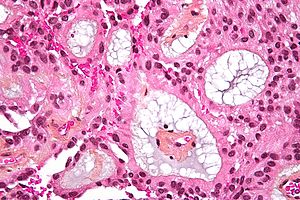Myxopapillary ependymoma
Jump to navigation
Jump to search
Mxyopapillary Ependymoma, is a low-grade Ependymoma. It is nearly always associated with cauda equina and filum terminale.
| Myxopapillary ependymoma | |
|---|---|
| Diagnosis in short | |
 Myxopapillary ependymoma. H&E stain | |
|
| |
| LM | Papillary tumor cells around vascular myxoid matrix |
| Subtypes | subtype of ependymoma |
| LM DDx | ependymoma |
| Stains | Alcian blue +ve |
| IHC | GFAP +ve |
| Site | usually lumbar spinal cord |
|
| |
| Prognosis | good (WHO Grade I) |
General
- Low-grade ependymoma - WHO Grade I by definition.
- Classically in the spinal cord of adults.
- Approx 9-13% of all ependymal tumors.[1]
- Associated with back pain.
- Enhancing mass
Gross
- soft.
- gray.
- discrete masses.
- often encapsulated.
- Subtotal resected tumors may spread throughout the neuraxis.
Histology
Features:
- Papillary appearance.
- Perivascular pseudorosettes:
- Cuboidal to elongated tumor cells.
- Radially arranged around vascular cores.
- Myxoid material surround blood vessels.
- Microcysts.
- Low mitotic activity.
Note:
Cases with extensive sclerosis may mimic degenerative changes. [2]
DDx:
Images:
IHC
- GFAP+ve.
- S-100+ve.
- MIB-1 <1%.
Molecular
- Poorly characterized
- No consistent abberations.
See also
References
- ↑ Schiffer, D.; Chiò, A.; Giordana, MT.; Migheli, A.; Palma, L.; Pollo, B.; Soffietti, R.; Tribolo, A. (Aug 1991). "Histologic prognostic factors in ependymoma.". Childs Nerv Syst 7 (4): 177-82. PMID 1933913.
- ↑ Schittenhelm, J.; Becker, R.; Capper, D.; Meyermann, R.; Iglesias-Rozas, JR.; Kaminsky, J.; Mittelbronn, M.. "The clinico-surgico-pathological spectrum of myxopapillary ependymomas--report of four unusal cases and review of the literature.". Clin Neuropathol 27 (1): 21-8. PMID 18257471.